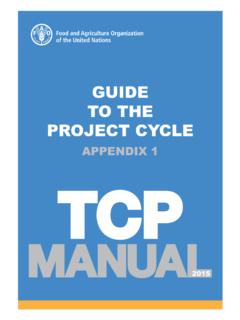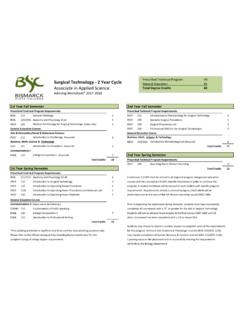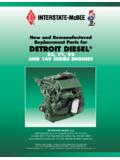Transcription of 2.3 Spare Parts Cycle Management - JICA …
1 Spare Parts Cycle Management Management of equipment is sustained by proper Management of Spare Parts . It can be said that achievement of medical equipment Management depends on whether the Spare Parts Management (or Spare Parts control) can be properly done. Spare Parts Management requires a broad range of technology, experience and knowledge of medical equipment. In addition to this, it requires the ability to estimate necessary Spare Parts . If C/Ps are able to carry out Spare Parts Management , technology transfer in the field of medical equipment Management will be enhanced. Technology transfer in the area of Spare Parts Management is, therefore, one of the most important tasks in MMS. Classification of Spare Parts Spare Parts are essential for maintaining and repairing medical equipment. Accessories and consumable components that have been described so far are necessary for maintenance and inspection.
2 Components including these accessories and consumable components that are used for maintenance and repair will generically be referred to as Spare Parts from now on. The Spare Parts are classified into various categories as shown in Figure according to lifespan and purpose for use. Usage Lifespan Examples Spare Parts For maintenance Less than 1 year 1-3 years Lamps for: Bilirubin meters, Endoscopes, Laryngoscopes Microscopes Operating lights Spectrophotometers, etc. 5-7 years Manufacture s instruction Filters for Infant incubators, Nebulizers, Oxygen concentrators Sterilizers, etc. Back-up batteries, Breathing hoses for anaesthesia apparatus, Electrodes for pH meters, Heaters for sterilizers, Motor brushes for centrifuges, Oxygen sensors for anaesthesia apparatus, etc Doppler probes, Ultrasonic probes, X-ray tubes, Charge-discharge capacitors for defibrillators, Fan motors for infant incubators, Vaporisers for anaesthesia apparatus, etc Bacteria filters for infant incubators, UV lamps for tilitFuses, Potentiometers, Stepping motors, Push switches, Recording heads, : Diodes, ICs, Transistors, TRIACs, etc.
3 Electronic Parts : Capacitors, Crystal oscillation devices, Coils, Resistors, etc. For repair Use for repair Use for maintenance Long life-spanSemi- permanent Figure Classification of Spare Parts according to the usage and life-span part Two: Basic Maintenance and Management of Medical Equipment 62 According to their purpose, Spare Parts are classified into one of two categories: that of maintenance and that of repair. The Spare Parts used for maintenance (maintenance Parts ) are classified into five groups according to the lifespan as shown in Figure Spare Parts used for repair (repair Parts ) are mainly used for random and wear-out failures, and are divided into two groups; those of long lifespan and those of semi-permanent lifespan. The maintenance Parts are required to conform to particular specifications of the equipment. On the other hand, most semiconductor Parts and electronic Parts , which are used as repair Parts , can be used on any equipment.
4 However, advanced technique is often required in repair work that utilises semiconductor and electronic Parts . However, maintenance Parts often belong to the category of Spare Parts for repair, because they deteriorate or breakdown. Conversely, repair Parts are used for carrying out the preventive repair, , faults found during inspection of equipment. Thus, use of the maintenance Parts and repair Parts often overlaps. In general, costly PCBs are stocked even for general medical equipment because there is lack of advanced repair technique that utilises semiconductor and electronic Parts . However, as failure occurrence on PCBs is rare, almost all PCBs that are stocked will possibly become "dead stock" before use. If costly PCBs are stocked without an explanation of when they will be needed, it is an extravagant expense of money Note ). On the other hand, equipment worth tens of thousands of dollars might become irreparable due to unavailability of PCBs.
5 Therefore, it is necessary to consider stocking PCBs rationally and economically. Larger stocks of electric and electronic Parts are encouraged because they are not expensive, and can be used commonly for any equipment, capacitor set, diode set, fuse set, IC set, resistor set and transistor set. Section Responsible for Spare Parts Management One of the difficulties in Spare Parts Management is to determine which section should manage it. For instance, Spare Parts Management is sometimes left to individual wards after distribution. But this is not a rational strategy, because these Spare Parts will be locked away or not properly arranged unless the ward manager has high consideration for Spare Parts . As a result, the Spare Parts may not be effectively used. In Islamabad Children's Hospital for example, staff in the store section took special training on logistics Management and had no problems with their routine work.
6 However, they did not know much about Spare Parts technically, making it difficult for them to prepare the Spare Parts requested by the ME section even if the Spare Parts were available. For this reason, the store section recommended that Spare Parts be managed under the ME section. In NMCHC for example, Spare Parts including consumables are managed by the ME section under the direct control of Hospital Administrative Bureau (see also Photo ). However, the Accounting Bureau prefers to manage Spare Parts while the Administrative Bureau preferred that the ME section manage them. In the case of Bach Mai General Hospital, Vietnam for example, the ME section carries out all activities of equipment Management from procurement to distribution of medical goods, instrument Parts and Spare Parts , etc. In this hospital, handling specialised materials was established and left with the ME section.
7 Photo Arrangement of Spare Parts in warehouse of NMCHC part Two: Basic Maintenance and Management of Medical Equipment 63 Thus, responsibility for Management of Spare Parts varies according to hospital Management policy. It is rational that goods used in a specific section are managed under the specialised section for effective use. Therefore, it is encouraged that Spare Parts and consumables for medical equipment be managed by the ME section. However, it is necessary to continue training personnel for establishing rational Management of Spare Parts . Carrying Out Spare Parts Cycle Management Generally speaking, Spare Parts for medical equipment in developing countries are expensive and valuable assets. Therefore the Spare Parts are required to be managed economically and reasonably, and for this reason, carrying out Spare Parts Cycle Management is important.
8 Such Management completes one Cycle in one year, which is similar to the medical equipment maintenance Cycle . The basic flow of the Spare Parts Management is shown in Figure - Registration - Inventory list Stock control Delivery Use Procurement Stocked and newly procured Spare Parts should be registered. Based on this, an inventory list, which shows the current balance of each Spare part is made. Stock control is carried out to ensure inventory accuracy (this means the process covering the delivery, registration, use and stocktaking). Stock taking or inventory check Estimation Figure Basic Spare Parts Management flow Stocktaking (or inventory check) is carried out to ensure accurate stock confirmation comparing between the numbers of use and inventory figures. Stock-shortage or newly required Spare Parts found during the stocktaking will be estimated for procurement, which is carried out according to the existing Government or Hospital Rules and Regulations.
9 Acquired Spare Parts are stocked and added to registration and the inventory afresh. A practical example of the Spare Parts Cycle Management being operated in NMCHC is illustrated in Figure Spare Parts Cycle Management is divided into two components, stock control and procurement. These components are actually operated in connection with the internal procedure. In the stock control component, delivery, stock, registration and distribution are processed in turn. Records of information such as name, specifications and code numbers of Spare Parts and make of registration, and inventory list are very important systems to monitor the number and kind of individual Spare Parts . In addition, carrying out the inventory check that compares and confirms across the actual inventory and the record is necessary to do an accurate stock control. In the procurement process, the store manager estimates necessary Spare Parts based on the result of the inventory except upon urgent request.
10 This estimation is sent to the Administrative Bureau that manages the ME section in the form of a proposal which is checked, after which it is sent to the Drugs and Material Procurement Committee, where it is counter-checked. The counter-checked proposal is sent to the Accounting Bureau and then to the hospital director for approval and later is returned to the drug and material procurement committee. This committee executes procedures of marketing research, inventory check, tender and contract, etc., and carries out the purchasing. The acquired Spare Parts are stocked before they are used, and the remaining Spare Parts are kept in storage. At this point, newly acquired Parts are included on the inventory list. This list is balanced by comparing the Parts entry/register and Parts delivered to stations or wards. part Two: Basic Maintenance and Management of Medical Equipment 64 Procurement The above-mentioned main procedures are explained as follows: 1) Registration and Inventory List Each stocked and newly procured Spare part is given a hospital code number.






